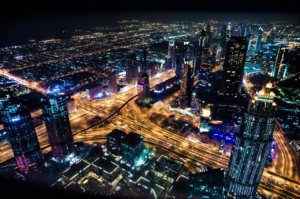With companies like FedEx and Maersk forecasting decreased revenues over the coming months as a result of the repressed global economy, trying to find upbeat economic news has become a challenge. “If there’s any bright spot in an otherwise dim outlook for the global economy,” writes Richard Dobbs, director of the McKinsey Global Institute, and Jaana Remes, a MGI fellow, “it’s the rise of cities.” [“Introducing … The Most Dynamic Cities of 2025,” Foreign Policy, September/October 2012] Dobbs and Remes note that the west is witnessing fragile growth at best and that “the shift in economic balance toward the East and South is happening with unprecedented speed and scale — and it’s happening through urbanization.” They claim we are witnessing “the biggest economic transformation the world has ever seen.” As people continue to move into cities in emerging markets, Dobbs and Remes believe “their incomes [will] rise as never before, producing massive geopolitical shifts and a wave of new consumers whose spending power will change the way the world shops and invests.”
I’ve noted in past posts that fostering a rising middle class is critical for sustaining global economic growth. There’s nothing particularly profound about that observation. Most people understand that a healthy middle class is required to support a healthy economy (just listen to political advertisements for the U.S. presidential candidates). Dobbs and Remes point out that the middle class is fostered in urban, rather than rural, environments, which is why cities are critical to generating economic growth. They write:
“More than ever, cities matter. Today, just 600 urban centers generate about 60 percent of global GDP. But though 600 cities will continue to account for the same share of global GDP in 2025, this elite group will have a very different membership. Over the next 15 years, the urban world’s center of gravity will move farther south and, even more decisively, east.”
To no one’s surprise, Dobbs and Remes predict that 40 percent of the world’s most dynamic cities in 2025 will be located in China. They continue:
“The West will not be quite eclipsed by 2025 — 13 U.S. cities make the list, though only three in Europe — but the sun is indeed setting. Even beyond the extraordinary 29 Chinese cities on the list, there are many — from Luanda to Abu Dhabi, Ankara to Santiago — that were small towns of the last century but are likely to be household names a few decades from now.”
The McKinsey Global Institute assembled a list of 75 cities that it predicts “will make the greatest contribution to the global economy in the coming years. Put together, they are likely to supply more than 30 percent of all GDP growth between now and 2025. They are the world’s economic engines.” You can find a copy of the list by following this link. The list ranks cities based on a combination of population and economic growth projections. What comes to mind for many people when they hear about rapid urban population growth is urban blight and slums. It’s hard to imagine a middle class rising from such conditions. However, in the same issue of Foreign Policy in which the Dobbs’ and Remes’ article appears, Charles Kenny has an article about slums. [“In Praise of Slums“] Kenny doesn’t sugarcoat conditions found in urban slums. He writes about “the stench of open sewers, the choking smoke of smoldering trash heaps, [and] the pools of fetid drinking water filmed with the rainbow color of chemical spills” that found in many slums. But he also argues that poor people living in slums are generally better off than poor people living in rural areas. He explains:
“Most people who’ve experienced both rural and urban poverty choose to stay in slums rather than move back to the countryside. That includes hundreds of millions of people in the developing world over the past few decades — and 130 million migrant workers in China alone. … For all the real horrors of slum existence today, it still usually beats staying in a village. Start with the simple reason that most people leave the countryside: money. Moving to cities makes economic sense — rich countries are urbanized countries, and rich people are predominantly town and city dwellers. … Slum dwellers may be at the bottom of the urban heap, but most are better off than their rural counterparts. Although about half the world’s population is urban, only a quarter of those living on less than a dollar a day live in urban areas.”
Kenny points out that not everyone is optimistic about urbanization. He notes, “A recent opinion article in the New England Journal of Medicine called urbanization “an emerging humanitarian disaster.” And urban theorist Mike Davis writes in Planet of Slums, “[N]o one knows whether such gigantic concentrations of poverty are biologically or ecologically sustainable.” Despite such concerns, Kenny writes that “slum living today, for all its failings” is better than the alternative. “Data from surveys across the developing world suggest that poor households in urban areas are more than twice as likely to have piped water as those in rural areas, and they’re nearly four times more likely to have a flush toilet.” But indoor plumbing isn’t the measure by which most people gauge quality of life. Kenny admits, “Slum life remains grim.” Nevertheless, he concludes:
“All things considered, slum growth is a force for good. It could be an even stronger driver of development if leaders stopped treating slums as a problem to be cleared and started treating them as a population to be serviced, providing access to reliable land titles, security, paved roads, water and sewer lines, schools, and clinics. As Harvard University economist Edward Glaeser puts it, slums don’t make people poor — they attract poor people who want to be rich. So let’s help them help themselves.”
That’s really the bottom line. Helping the poor emerge from poverty into the middle class is what is going to drive the global economy in the decades ahead. Fail to do that and the global economy will stagnate. One course of action would be to help ensure that new urban dwellers move into modest, but well-planned, communities prepared to provide proper social services and ready to put people to work. With most countries (and cities) reeling under the weight of debt, that won’t be easy (or maybe even possible) to do. Nevertheless, we haven’t got much time to plan. Dobbs and Remes report:
“China’s urbanization is thundering along at an extraordinary pace; it’s happening at 100 times the scale of the world’s first country to urbanize — Britain — and at 10 times the speed. Over the past decade alone, China’s share of people living in large cities has increased from 36 percent to nearly 50 percent. In 2010, China’s metropolitan regions accounted for 78 percent of its GDP. If current trends hold, the Middle Kingdom’s urban population will expand from approximately 570 million in 2005 to 925 million in 2025 — an increase larger than the entire current population of the United States.”
Dobbs and Remes admit that “the destinies of metropolises vary widely depending on the wisdom of their leaders, broad economic trends, the success of local business endeavors, and, of course, luck.” The first century Roman philosopher Seneca once wrote, “Luck is what happens when preparation meets opportunity.” If the global economy is going to be saved by cities, then a lot of preparation needs to be undertaken. In another Foreign Policy article in the “cities issue,” Peter Calthorpe indicates that there are few signs that such preparations are being carried out. In fact, he claims, “China’s cities are making the same mistake America made on the path to superpower status.” [“Weapons of Mass Urban Destruction“] He writes:
“The choices China makes in the years ahead will have an immense impact not only on the long-term viability, livability, and energy efficiency of its cities, but also on the health of the entire planet. Unfortunately, much of what China is building is based on outdated Western planning ideas that put its cars at the center of urban life, rather than its people. And the bill will be paid in the form of larger waistlines, reduced quality of life, and choking pollution and congestion. The Chinese may get fat and unhappy before they get rich.”
Calthorpe argues that “China’s fundamental problem [is that] cities [are being] designed to accommodate cars, not human beings.” He concludes:
“China’s leaders have a limited window of opportunity to plan for prosperous, livable, low-carbon cities. They have the resources and the wherewithal to make the sweeping changes required to avert an impending social and environmental disaster of proportions unknown in human history. It might seem strange to think that a budding superpower must make shorter commutes, public transport, walking, and bicycling its top priorities. But unless it does, China’s powerful economic engines — its cities — will slowly grind to a halt.”
China is not alone in needing to make cities more livable. The trend towards urbanization is likely to continue for a lot of good reasons; but accommodations must be made to improve the quality of urban dwelling. The world’s economic future rests on the shoulders of a middle class that is only beginning to emerge. If it doesn’t blossom as predicted, the coming decades could be bleak indeed. The non-government sector has a role to play in all of this. Companies can develop and market products specifically targeted for urban residents. They can help provide work, support infrastructure development, foster education and training, and so forth. It will take a combined effort of public and private organizations to ensure that global middle class emerges and remains viable.




